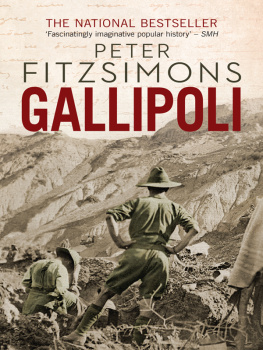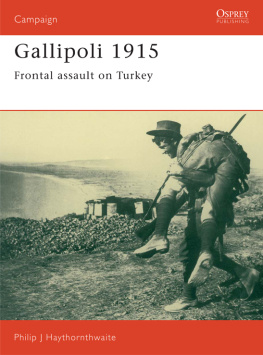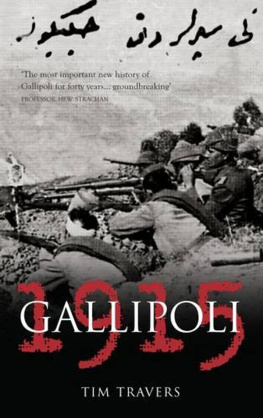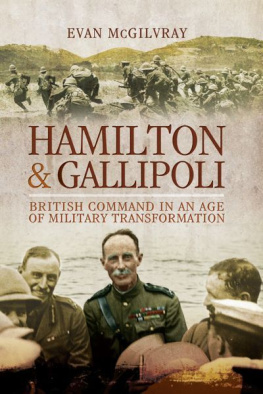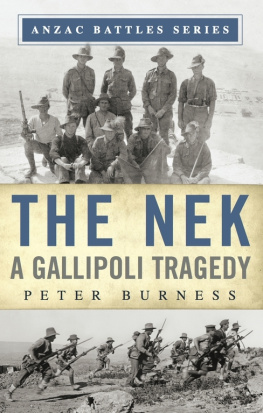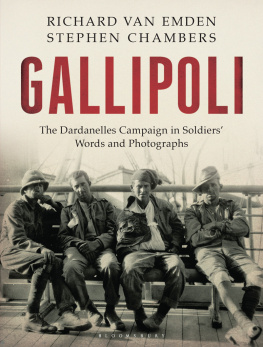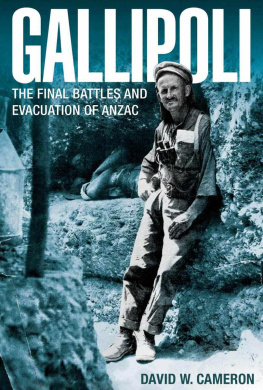GALLIPOLI
R OBIN P RIOR is visiting professorial fellow, University of Adelaide, and visiting fellow, University of New South Wales, Australian Defence Force Academy. He is coauthor with Trevor Wilson of Passchendale: The Untold Story (1996) and The Somme (2005), both published by Yale.

For Mark, Cathy and Isabella
Copyright 2009 Robin Prior
First printed in paperback 2010
All rights reserved. This book may not be reproduced in whole or in part, in any form (beyond that copying permitted by Sections 107 and 108 of the U.S. Copyright Law and except by reviewers for the public press) without written permission from the publishers.
For information about this and other Yale University Press publications, please contact:
U.S. Office:
Europe Office:
Set in Minion by IDSUK (DataConnection) Ltd.
Printed in Great Britain by MPG Books, Bodmin, Cornwall
Library of Congress Cataloging-in-Publication Data
Prior, Robin.
Gallipoli : the end of the myth / Robin Prior.
p. cm.
Includes bibliographical references and index.
ISBN 978-0-300-14995-1 (ci : alk. Paper)
1. World War, 19141918CampaignsTurkeyGallipoli
Peninsula. 2. Gallipoli Peninsula (Turkey)History, Military. I. Title.
D568.3.P76 2009
940.426dc22
2008044682
A catalogue record for this book is available from the British Library.
ISBN 9780300168945 (pbk)

The paper used for the text pages of this book is FSC certified. FSC (The Forest Stewardship Council) is an international network to promote responsible management of the world's forests.
10 9 8 7 6 5 4 3 2 1
Contents
Maps
Acknowledgements
I wish to acknowledge both the institutions and the many people who have helped me in the research and production of this book.
First, I would like to thank my colleagues at the Australian Defence Force Academy for their support, which has been much appreciated. In particular, I would like to thank Elizabeth Greenhalgh for help in obtaining sources, especially those in French, and for many fruitful discussions on Gallipoli. I would also like to thank John Coates, John Reeves and Vice Admiral James Goldrick.
To John Baird, Rector of UNSW@ADFA, I am grateful for the provision of money to make myself acquainted with the Gallipoli Peninsula. My trip to Gallipoli was made much more fruitful and constructive by the expert guidance of Mehmet Ali Oneren and Aykut Degre.
I would also like to thank Professor David Lemmings and my new colleagues at the University of Adelaide for making me so welcome.
I wish to thank the National Maritime Museum, Greenwich and the Liddell Hart Centre at King's College, London and the Churchill Archives for granting access to their collections and for permission to quote from them. The National Archives, Kew deserves particular praise. Surely it is the most efficient research centre in the world; it is a real pleasure to work there.
As always, I owe a special thanks to Rod Sudderby and his staff at the Imperial War Museum. Rod drew my attention to several collections, access to which has improved this book immeasurably.
The Australian War Memorial deserves a special thank you. Steve Gower, Helen Withnell, Ashley Ekins and their staff came to my aid and allowed me access to the AIF war diaries at a difficult moment. This would have been a quite different book and a poorer one but for their intervention. They also allowed me privileged access to their photographic collection for which I am very grateful. The debt owed by me to this splendid institution is immense.
Ashley Ekins deserves special mention. He has always been available for help and advice in his position as Principal Historian in the Australian War Memorial. His encyclopaedic knowledge of the AWM collections is truly remarkable.
Jay Winter has been an enthusiast for this book from the moment I commenced writing. His encouragement and confidence in the manuscript have meant more to me than he knows. Any author with a friend such as Jay is very fortunate.
This is the fourth book with which I have been associated for which Keith Mitchell has drawn the maps. For once again bringing clarity to a very basic scrawl, I owe a great debt to Keith.
I would also like to express my gratitude to Robert Baldock and his expert team at Yale University Press, London. Richard Mason has been a copy editor par excellence and has saved me from many an error. Robert, as ever, has been an encouragement throughout the project. His wise counsels have invariably proved correct. I regard him as my friend as well as my publisher.
My wife Heather has been my greatest supporter, acting as guide, critic and researcher. She has read the entire manuscript (more than once) and her suggestions have invariably led to a better and more readable book. This book belongs to her as much as it belongs to me.
My daughter Megan has been a source of joy and a lift for sagging morale.
Cleo and Georgia were my constant companions while I was typing this book. Any errors belong to them.
Introduction
M ilitary history is replete with tales of battles and campaigns, even whole wars, that hung in the balance by the slenderest of threads, the outcome only reached by the commitment of the last reserves or a final effort of willpower by the commander or his troops. Thus we are led to the narrow margin by which many conflicts are said to have been decided. In this way of thinking the battle of Waterloo was a close run thing which might well have gone the other way had Napoleon only persisted with his cavalry charges.
The Second World War provides a particularly rich harvest of examples of this kind. The Battle of Britain is widely regarded as an action that Britain only won because a misguided Luftwaffe turned its attentions in September 1940 to the bombing of London. Had the Luftwaffe kept up their attacks on the airfields of Fighter Command, the story goes, it might well have won the battle. In keeping with this popular view, Park's famous response to Winston Churchill's enquiry about fighter reserves, We have no reserves, is far more likely to make it into print than the figures that show Britain out-producing Germany in aircraft by an ever increasing margin.
In the same vein it is suggested that if the Germans had started their eastern campaign one or two weeks earlier in June 1941, Moscow and perhaps the entire Soviet state might well have fallen before the Russian winter ground the blitzkrieg to a halt. Similarly, one more push at Stalingrad in August 1942 and the Germans would have been across the Volga. Only Rommel's failure to realize that he was on the brink of success in early 1942 allowed the British to hang on in the Western Desert. (The failure of Montgomery to realize later in the same year that he had Rommel on the ropes prolonged the desert campaign into 1943, and thus delayed D Day into 1944.) The list goes on.
The military history of the First World War has, in general, been free of this kind of brinkmanship in the literature. There have been few suggestions that many of its battles were close run. On the contrary, at the Marne in September 1914 the Germans are portrayed as exhausted, fortunate to have proceeded as far as they had. In the great French battles of 1915 in the Artois (spring) and Champagne (autumn), historians have not discovered any actions by which the commanders could have turned defeat into victory; indeed, the consensus is that these battles should not have taken place at all.
Next page






